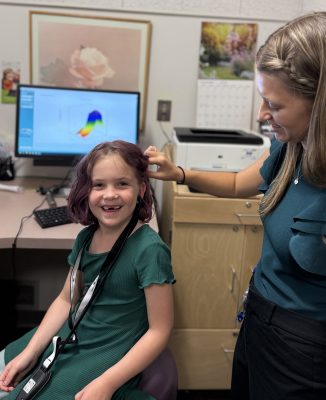
Advanced diagnostic capabilities are being taught in class and put into clinical practice in UConn’s Department of Speech Language and Hearing Sciences.
(Picture posted with permission) Second year Au.D. student, Emily O., performed Wideband Acoustic Immittance (WAI) on a young patient this week who has been experiencing middle ear dysfunction. WAI has been used in research for many years and is finally finding its way into clinical practice. While traditional tympanometry measures the energy transmission of the middle ear at one frequency, WAI can quickly measure the energy transmission across a broad frequency range. This provides a much more detailed picture of how the middle ear is functioning and can improve differential diagnosis and treatment recommendations.
WAI has several advantages over single frequency tympanometry. The response obtained can differentiate whether a patient has a partial effusion or a full effusion which can help to determine if “watchful waiting” or medical intervention is recommended. In one measurement, it can also compare the absorbance of the middle ear at peak pressure and at atmospheric pressure which can support a diagnosis of Eustachian tube dysfunction. There are recognizable responses that can point to other disorders of the middle ear like otosclerosis, cholesteatoma, and ossicular discontinuity.
Dr. Terry Yanaway (clinical professor) has completed extensive continuing education on WAI and is championing its use through teaching about it in the Pediatric Audiology Assessment class and putting it into practice in the UConn Speech and Hearing Clinic. When asked about how it has improved her clinical practice she explained, “The signal used for WAI uses a broad click and averages the response. Many of the young children I see for testing in the clinic are suspected of being on the autism spectrum. Completing tympanometry has always been difficult for these kids, but with the averaging, WAI can usually show me a response that rules out any significant middle ear problem. I rarely need to repeat the testing which saves time and is a lot more comfortable for the patient and their family.”
Many thanks to all the translational researchers who are promoting advances in audiology #boystownaudiology